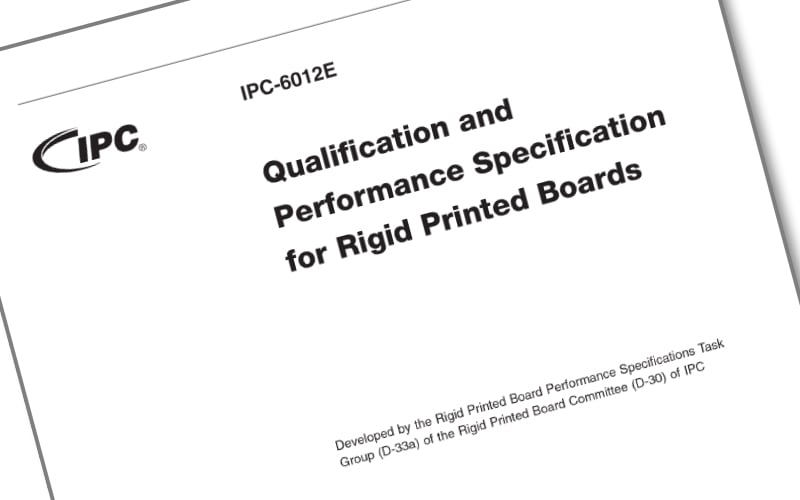The purpose of IPC specification is to provide requirements for qualification and performance of rigid printed circuit boards based on the following constructions and/or technologies. These requirements apply to the finished product unless otherwise specified.
These include single-sided, double-sided circuit boards with or without plated-through holes (PTH); multilayer printed circuit boards with PTHs with or without buried/blind vias/microvias; active/passive embedded circuitry circuit boards with distributive capacitive planes and/or capacitive or resistive components; and metal core circuit boards with or without an external metal heat frame, which may be active or non-active.
IPC-6012 Challenges
When it comes to IPC-6012, the biggest challenge for misinterpretation, and I find this to be true amongst many customers, is determining the correct thickness of copper both internally and externally compared to prints and compared to IPC. What happens is in the IPC-6012, you have two tables. You have table 3-13, which is for internal copper thicknesses, and you have table 3-14 for external copper thicknesses. Customers’ incoming inspection will refer to those tables when viewing their micro-sections or documentation and consider the copper weights on the far left-hand side as finished requirements. The problem they don't review the fine print which states that the far left-hand column is the copper weight of the starting laminate. That's before you do anything to it before you do any processes. It is the copper weight of the laminate that comes in and in the stock room ready for production.

IPC-6012 Qualification and Performance Specification for Rigid Printed Boards.
Now, internal layers only have reduction processes. There are no additive processes, so if you have a 1-ounce internal layer callout, even though the starting is 34 micrometers, IPC allows the minimum of the finished products to be 25 micrometers. The reason being is that you have to put an image on the inner layers and it tends to be an etching processes, so it can be less. That's the part that is misunderstood by many. They don't see it that way. They see the 34 micrometers and they think that's what it should be.
On the other hand, the external copper table must be viewed differently because external copper has additive processes. Now you must plate copper on top of the starting copper to fill in plated through holes. So, the finished copper will be higher than what the starting weight is. For example, on 1-ounce copper, the absolute minimum is 30 micrometers, but that is with the starting laminate. After all processes IPC expects a minimum for Class I and II of 48 micrometers and for Class III, 53 micrometers.
Again the misunderstanding by customers is they see that first column, where it says copper weight, and they're interpreting that as finished copper weight, and it really isn't. It is starting copper weight.
Misinterpretations
As far as creating prints, it's always a good idea for the customers when it comes to copper weights, to actually state starting or finished. Some customers do that and if they say they want 1-ounce copper starting weight, then that's telling us that the laminate before we do anything, has to be 1-ounce copper. That's fine. If customers say they have a 1-ounce finished copper requirement (externally), then that means we're going to start with a half-ounce copper, because again, we're going to add plating to it, so that's how we get to the finished 1 oz. When a print states a copper weight and doesn't say start or finish, we interpret it as finished. That is the industry standard. If there’s nothing there, you interpret it as finished copper.
They can avoid questions if they put starting or finished on the print next to that copper requirement. Sometimes prints will state an exact minimum measurement, such as 70 micrometers as finished copper. This is a bit heavier than 2oz, but as a PCB fabricator, to hit that minimum, I will have to start with 2oz copper laminate. This will effectively give the customer a 3oz finished copper part, which they will be paying for, when all they really wanted was a 2oz finished part. It is probably wiser, and more cost-effective to stick with rounded copper weights and leave the exact numbers to the class of IPC that the parts are being built to.
Summary
There are many other issues that can be misinterpreted in IPC-6012, such as solder mask clearances, solder mask thicknesses, and surface finish thicknesses, but copper weight remains the most prevalent. It's really important that PCB designers state copper weights properly on their drawings and fully understanding the tables in IPC-6012 will be extremely beneficial in this endeavor.
Key Takeaways
- Starting vs. Finished Copper Weight Is Often Misunderstood: One of the most common mistakes is interpreting IPC-6012’s copper weight tables incorrectly. Many users assume the left-most column in Tables 3-13 and 3-14 indicates finished copper weight, when it actually refers to starting copper weight before any processing.
- Internal vs. External Layers Have Different Requirements: Internal copper layers go through subtractive processes (etching), so their final thickness may be lower than the starting value. In contrast, external layers involve additive plating processes, requiring higher final copper thickness than what was originally on the laminate.
- Specifying ‘Starting’ or ‘Finished’ on Prints Prevents Miscommunication: Clearly stating whether copper weight requirements refer to starting or finished thickness on design prints eliminates ambiguity. If unspecified, the industry standard is to assume the weight refers to finished copper.
- Incorrect Copper Weight Calls Can Lead to Unnecessary Costs: Misstating the required copper thickness can lead to overbuilding the PCB, which increases material and manufacturing costs. For instance, specifying a finished thickness in micrometers without considering IPC tolerances may result in the fabricator using unnecessarily thick starting copper.
- A Strong Understanding of IPC-6012 Helps Avoid Costly Mistakes: Beyond copper weights, other areas of IPC-6012, like solder mask and surface finish tolerances, are also prone to misinterpretation. Designers who understand the full scope of IPC-6012, and how to apply it correctly, help ensure their boards are both compliant and cost-efficient.
















